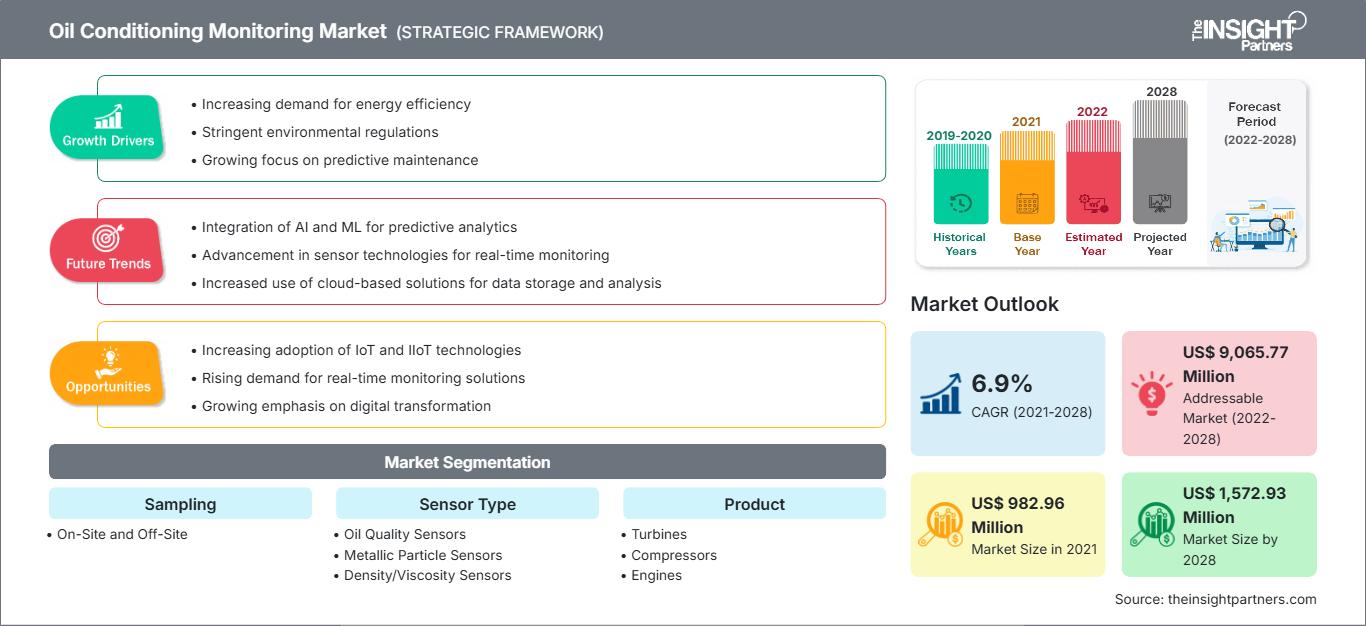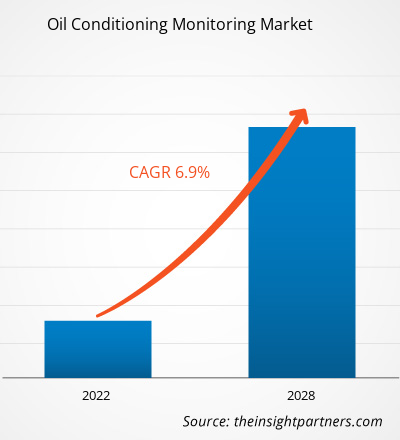Der Markt für die Überwachung der Ölkonditionierung soll von 982,96 Millionen US-Dollar im Jahr 2021 auf 1.572,93 Millionen US-Dollar im Jahr 2028 wachsen; für den Zeitraum 2021–2028 wird eine durchschnittliche jährliche Wachstumsrate (CAGR) von 6,9 % geschätzt.
Die Nutzung des industriellen Internets der Dinge (IIoT) reduziert die Umweltbelastung der Öl- und Gasindustrie erheblich, von erhöhter Effizienz über geringere Sicherheitsrisiken bis hin zu weniger Reisen. Öl- und Gasunternehmen achten auf das IIoT, weil es ihnen helfen kann, Energie zu sparen, Ölverschmutzungen und andere Katastrophen zu vermeiden und weniger Kohlenstoff auszustoßen. Das IIoT kann auch den Energieverbrauch und den Ressourcenverbrauch überwachen. Intelligente Technologien beeinflussen praktisch jeden Bereich der Öl- und Gaslieferkette, vom Betrieb bis zur Interaktion mit dem Verbraucher. Smarte Geräte in der Lieferkette geben der Öl- und Gasindustrie die Chance, in einer standardisierten Welt wettbewerbsfähig zu bleiben und sich in einem veralteten Sektor schnell zu modernisieren. Darüber hinaus bietet das Internet der Dinge (IoT) das Potenzial, die Datenerfassungsmethoden deutlich zu verbessern. Der Öl- und Gassektor legt wie kaum eine andere Branche mehr Wert auf Effizienz und Präzision.
Passen Sie diesen Bericht Ihren Anforderungen an
Sie erhalten kostenlos Anpassungen an jedem Bericht, einschließlich Teilen dieses Berichts oder einer Analyse auf Länderebene, eines Excel-Datenpakets sowie tolle Angebote und Rabatte für Start-ups und Universitäten.
Markt für die Überwachung der Ölkonditionierung: Strategische Einblicke

-
Holen Sie sich die wichtigsten Markttrends aus diesem Bericht.Dieses KOSTENLOSE Beispiel umfasst Datenanalysen, die von Markttrends bis hin zu Schätzungen und Prognosen reichen.
Die COVID-19-Pandemie hat weltweit zahlreiche Branchen erschüttert. Der Lockdown behinderte den Betrieb verschiedener Branchen, darunter Fertigung und IT. Wichtige Branchen wie die Produktion schnelldrehender Konsumgüter (FMCG) und die Pharmaindustrie mussten jedoch ihren Betrieb fortsetzen. Der Ölsektor erlebt seinen dritten Preissturz innerhalb der letzten zwölf Monate. Die Branche erholte sich von den ersten beiden Schocks, und der normale Geschäftsbetrieb wurde wieder aufgenommen. Diesmal jedoch liegen die Dinge anders. Die aktuelle Situation umfasst einen Angebotsschock, eine historisch niedrige Nachfrage und eine weltweite humanitäre Katastrophe. Zudem ist die finanzielle und strukturelle Verfassung des Sektors schlechter als in früheren Krisen. Die schlechten Renditen werden auf die Einführung von Schieferöl, Überproduktion und liberale Finanzmärkte zurückgeführt, die die mangelnde Kapitaldisziplin ignorierten. Angesichts der Preise nahe 30-Jahrestiefs und des zunehmenden öffentlichen Drucks erkannten die Verantwortlichen, dass Veränderungen unvermeidlich sind. Das COVID-19-Problem verschärft sich. Daher richten die COVID-19-Epidemie und ihre Auswirkungen verheerende Schäden auf dem Markt für Ölaufbereitungsüberwachung an.
Markteinblicke in die Ölaufbereitungsüberwachung: Steigende Nachfrage nach Stromerzeugung weltweit treibt Wachstum des Marktes für Ölaufbereitungsüberwachung an
Der weltweite Energieverbrauch wird in den kommenden Jahren voraussichtlich steigen und bis 2035 aufgrund des prognostizierten Anstiegs der Weltbevölkerung sowie des wirtschaftlichen und industriellen Wachstums in Entwicklungsländern wie China und Indien einen jährlichen Verbrauch von ca. 778 Ettajoule erreichen. Konstrukteure und Hersteller von Industriemaschinen und anderen Geräten suchen ständig nach Möglichkeiten, die Energieeffizienz ihrer Produkte durch Reduzierung von Heiz- und Kühlverlusten, Verbesserung der Wärmeübertragung und Verbesserung der Elektromotoren zu verbessern. Kernenergie bleibt aufgrund von Faktoren wie der Notwendigkeit einer zuverlässigen Grundlastversorgung mit Strom und der Bedrohung durch den globalen Klimawandel unverzichtbar. Darüber hinaus ist Kernenergie ein entscheidender Bestandteil der Energiestrategie, da sie die einzige großflächige Quelle nahezu kohlenstofffreier Elektrizität ist. Sie produziert etwa 20 % des weltweiten Stroms und mehr als 60 % der kohlenstoffarmen Energie. Kernkraftwerke haben sich als Energiequelle zur Deckung des gestiegenen Strombedarfs etabliert. Die Anlagen stehen vor dem Problem des nuklearen Brennstoffkreislaufs und müssen im Rahmen ihres Lebenszyklus oder im Falle einer Natur- oder von Menschen verursachten Katastrophe schließlich stillgelegt werden, was die Nachfrage nach Ölzustandsüberwachung in den Anlagen antreibt.
Markteinblicke auf Basis von Stichproben
Der globale Markt für Ölzustandsüberwachung ist stichprobenartig in On-Site- und Off-Site-Systeme unterteilt. Im Jahr 2020 hatte das Off-Site-Segment den größten Marktanteil, gefolgt vom Segment der Ölzustandsüberwachung.Markteinblicke auf Basis von Sensortypen
Nach Sensortypen ist der Markt für Ölzustandsüberwachung in Ölqualitätssensoren, Metallpartikelsensoren und Dichte-/Viskositätssensoren unterteilt. Im Jahr 2020 führte das Segment Ölqualitätssensoren das Segment Ölzustandsüberwachung an und hatte den größten Marktanteil.Produktbasierte Markteinblicke
Nach Produkten ist der Markt für Ölzustandsüberwachung in Turbinen, Kompressoren, Motoren, Getriebesysteme und Hydrauliksysteme unterteilt. Im Jahr 2020 führte das Segment Turbinen das Segment Ölzustandsüberwachung an und hatte den größten Marktanteil.Messbasierte Markteinblicke
Nach Messungen ist der Markt für Ölzustandsüberwachung in Temperatur, Druck, Dichte, Viskosität, Dielektrikum, TAN/TBN, Wasserverdünnung, Kraftstoffverdünnung, Ruß und Verschleißpartikel unterteilt. Im Jahr 2020 führte das Segment Viskosität das Segment Ölzustandsüberwachung an und hatte den größten Marktanteil.Branchenbasierte Markteinblicke
Nach Branchen ist der Markt für Ölzustandsüberwachung in Transport, Industrie, Öl und Gas, Energie und Strom sowie Bergbau unterteilt. Im Jahr 2020 führte das Transportsegment das Segment Ölzustandsüberwachung an und hatte den größten Marktanteil.
Die Akteure auf dem Markt für Ölzustandsüberwachung verfolgen Strategien wie Fusionen, Übernahmen und Marktinitiativen, um ihre Position auf dem Markt zu behaupten. Einige Entwicklungen der wichtigsten Akteure sind unten aufgeführt:
- Im August 2020 begann ALS eine strategische Zusammenarbeit mit Poseidon Systems, einem in Rochester ansässigen Entwickler fortschrittlicher Lösungen zur Online-Ölzustandsüberwachung (OCM). Die Unternehmen haben das gemeinsame Ziel, OCM zu transformieren, indem sie die preisgekrönte Online-OCM-Technologie von Poseidon Systems mit der Erfahrung von ALS in der Ölanalyse und -prüfung kombinieren.
- Im August 2020 hat die Des-Case Corporation, ein globaler Hersteller von Spezialfiltrationsprodukten, die die Zuverlässigkeit von Prozessanlagen verbessern und die Lebensdauer von Schmiermitteln verlängern, die Einführung eines neuen Abonnementplans für die Ferndiagnoseüberwachung von industriell geschmierten Anlagen angekündigt. Dadurch können Kunden sicher sein, dass Zustand, Sauberkeit und Feuchtigkeit des Schmiermittels in ihren kritischen Anlagen in Echtzeit überwacht werden.
Markt für die Überwachung der Ölkonditionierung
Die Analysten von The Insight Partners haben die regionalen Trends und Faktoren, die den Markt für Ölaufbereitungsüberwachung im Prognosezeitraum beeinflussen, ausführlich erläutert. In diesem Abschnitt werden auch die Marktsegmente und die geografische Lage in Nordamerika, Europa, dem asiatisch-pazifischen Raum, dem Nahen Osten und Afrika sowie Süd- und Mittelamerika erörtert.Umfang des Marktberichts zur Überwachung der Ölkonditionierung
| Berichtsattribut | Einzelheiten |
|---|---|
| Marktgröße in 2021 | US$ 982.96 Million |
| Marktgröße nach 2028 | US$ 1,572.93 Million |
| Globale CAGR (2021 - 2028) | 6.9% |
| Historische Daten | 2019-2020 |
| Prognosezeitraum | 2022-2028 |
| Abgedeckte Segmente |
By Probenahme
|
| Abgedeckte Regionen und Länder |
Nordamerika
|
| Marktführer und wichtige Unternehmensprofile |
|
Dichte der Marktteilnehmer im Bereich Ölaufbereitungsüberwachung: Verständnis ihrer Auswirkungen auf die Geschäftsdynamik
Der Markt für Ölaufbereitungsüberwachung wächst rasant. Dies ist auf die steigende Nachfrage der Endverbraucher zurückzuführen, die auf Faktoren wie veränderte Verbraucherpräferenzen, technologische Fortschritte und ein stärkeres Bewusstsein für die Produktvorteile zurückzuführen ist. Mit der steigenden Nachfrage erweitern Unternehmen ihr Angebot, entwickeln Innovationen, um den Bedürfnissen der Verbraucher gerecht zu werden, und nutzen neue Trends, was das Marktwachstum weiter ankurbelt.
- Holen Sie sich die Markt für die Überwachung der Ölkonditionierung Übersicht der wichtigsten Akteure
Der globale Markt für die Überwachung der Ölkonditionierung ist wie folgt segmentiert:
Nach Probenahme
- Vor Ort
- Außerhalb
Nach Sensortyp
- Ölqualitätssensoren
- Metallpartikelsensoren
- Dichte-/Viskositätssensoren
Nach Produkt
- Turbinen
- Kompressoren
- Motoren
- Getriebesysteme
- Hydrauliksysteme
Nach Messung
- Temperatur
- Druck
- Dichte
- Viskosität
- Dielektrikum
- TAN/TBN
- Wasserverdünnung
- Kraftstoff Verdünnung
- Ruß
- Verschleißpartikel
Nach Branche
- Transport
- Industrie
- Öl & Gas
- Energie & Energie
- Bergbau
Nach Geografie
- Nordamerika
- USA
- Kanada
- Mexiko
- Europa
- Frankreich
- Deutschland
- Italien
- Großbritannien
- Russland
- Rest von Europa
- Asien-Pazifik (APAC)
- China
- Indien
- Südkorea
- Japan
- Australien
- Rest von APAC
- Naher Osten & Afrika (MEA)
- Südafrika
- Saudi-Arabien
- VAE
- Rest von MEA
- Südamerika (SAM)
- Brasilien
- Argentinien
- Rest von SAM
Firmenprofile
- CM Technologies GmbH
- Des-Case
- Hydac Technology Limited
- Intertek Group Plc.
- Poseidon Systems
- Rheonics Group
- SGS SA
- Special Oilfield Services Co. LLC
- TAN Delta Systems Limited
- Veritas Petroleum Services
- Historische Analyse (2 Jahre), Basisjahr, Prognose (7 Jahre) mit CAGR
- PEST- und SWOT-Analyse
- Marktgröße Wert/Volumen – Global, Regional, Land
- Branchen- und Wettbewerbslandschaft
- Excel-Datensatz
Aktuelle Berichte
Verwandte Berichte
Erfahrungsberichte
Grund zum Kauf
- Fundierte Entscheidungsfindung
- Marktdynamik verstehen
- Wettbewerbsanalyse
- Kundeneinblicke
- Marktprognosen
- Risikominimierung
- Strategische Planung
- Investitionsbegründung
- Identifizierung neuer Märkte
- Verbesserung von Marketingstrategien
- Steigerung der Betriebseffizienz
- Anpassung an regulatorische Trends






















 Kostenlose Probe anfordern für - Markt für die Überwachung der Ölkonditionierung
Kostenlose Probe anfordern für - Markt für die Überwachung der Ölkonditionierung